
Cerro Pedernal
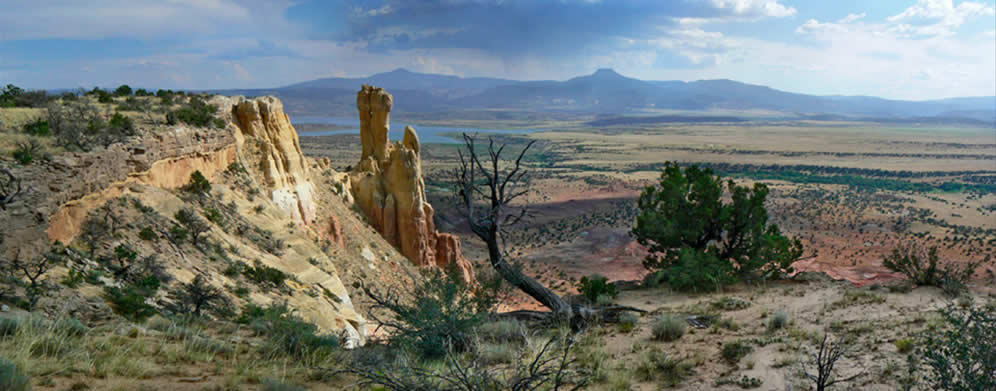 Photo: © Kirt Kempter, Geomosaics (used with permission)
Photo: © Kirt Kempter, Geomosaics (used with permission)
Location
Cerro Pedernal, one of the most recognized landmarks in north-central New Mexico, is located in the northern Jemez Mountains (Figures 1 and 2). Cerro Pedernal can be accessed by driving 27 miles northwest from Española on U.S. Highway 84, then turning west (left) onto New Mexico Highway 96 (Figure 2) toward Youngsville.
Travel 11.5 miles west on New Mexico Highway 96. Watch carefully for a small brown sign marking Forest Road 100, a gravel road on the left (south) side of the highway, and turn left. The left turn into Temoline Canyon (Forest Road 160) on the south side of Cerro Pedernal is located 5.7 miles south along Forest Road 100. You can park your car here and walk about 3 miles up the road to an open meadow at the base of the steep slope near the top Cerro Pedernal or you can drive a high clearance four-wheel drive vehicle to the meadow.
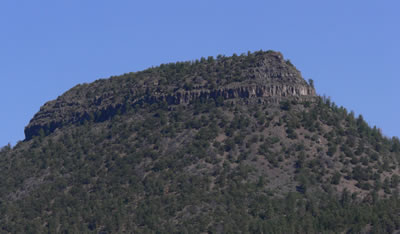
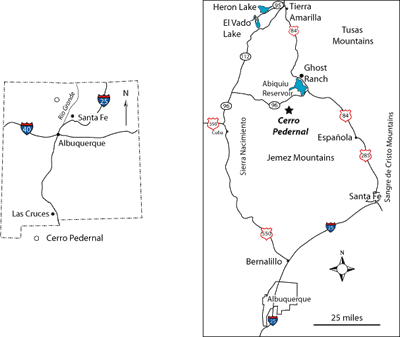
Regional Geologic Setting
Cerro Pedernal lies in the transition zone between the Colorado Plateau and the Rio Grande rift. Typical, relatively flat-lying, Colorado Plateau Mesozoic stratigraphy is exposed at the base of the mountain, while younger Cenozoic basin fill sediments underlie the shoulders of the peak. The andesite and basalt flows capping Cerro Pedernal, which give the mountain its distinctive flat top, were erupted from the northern Jemez volcanic field about 8 million years ago. The lava flows and underlying rocks on Cerro Pedernal and on mesas to the southeast have since been faulted and down-dropped to the southeast by as much as 1870 feet (570 m) during Rio Grande rift extension in the last 8 million years (Gonzalez and Dethier, 1991; Gonzalez, 1993).
Stratigraphy and Geologic History
Triassic
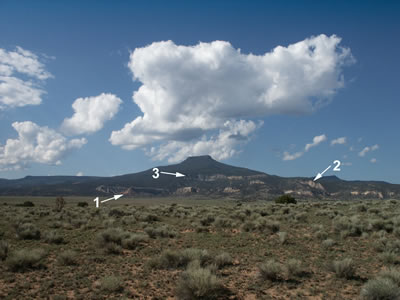
Late Triassic to Early Cretaceous sedimentary rocks are exposed around the northern and eastern base of Cerro Pedernal (Figures 3 and 4). The oldest unit, which is found in the cliffs just above the broad pediment surface north of Cerro Pedernal, is the Painted Desert Member of the Petrified Forest Formation of the Chinle Group (Figures 3 and 4). These red to green siltstones and mudstones were deposited on the floodplain of a large, west to northwest flowing river system about 205 to 210 million years ago.

Jurassic
A significant gap in the rock record (unconformity) spanning about 44 million years occurs between the late Triassic rocks and the middle Jurassic rocks on Cerro Pedernal. The oldest of the middle Jurassic rocks, the Entrada Sandstone, forms the prominent red, yellow, and white cliffs in this area. The Entrada Sandstone contains spectacular cross-beds that are several feet high, indicating an eolian (wind-blown sand) origin for this unit. The Entrada Sandstone deposits here are part of a vast sand dune field that covered much of northern New Mexico, southwestern Colorado, southeastern Utah, and northeastern Arizona (Korurek and Dott, 1983; Blakey, 1994; Peterson, 1994). Paleocurrent indicators show that the Entrada sands were transported by wind blowing toward the south to southwest (Tanner, 1965). The Entrada Sandstone is estimated to be approximately 161 to 165 million years old.
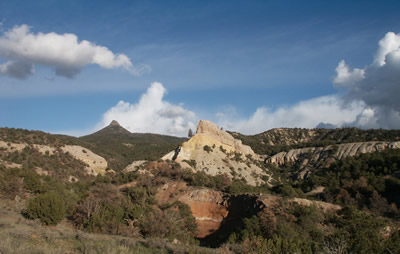
The contact between the Entrada Sandstone and the basal limestone member of the overlying Todilto Formation is relatively flat and fairly sharp, with minor interbedding of sandstone and limestone, which has led Ahmed Benan and Kocurek (2000) to speculate that that the Entrada dune field was flooded catastrophically, with very little reworking of the sand dunes. The Todilto Formation is composed of two units, a basal laminated shale and limestone (Mesa Luciano Member) and an upper gypsum deposit (Tonque Arroyo Member). The Todilto Formation was most likely deposited in a salina (Lucas et al., 1985); in other words, in a moderately deep, oxygen-poor, body of saline water that was isolated from the main body of the Jurassic ocean by a barrier. First, limestone precipitated from the evaporating sea water. Anderson and Kirkland (1960) noted that basal limestone was deposited in thin layers, with each layer consisting of limestone, clay, and dark organic material. Each layer, or varve, represents a one-year cycle related to seasonal variations in runoff, water temperature, and abundance of lake organisms. Anderson and Kirkland (1960) carefully counted the varves and found that it took 14,000 years for the basal laminated limestone to accumulate. Later, as the saline waters of the salina became more concentrated by evaporation, gypsum precipitated. The Todilto Formation is approximately 159 million years old, based on fossil evidence (Lucas et al.,1985).
The Todilto Formation grades up into the Jurassic Summerville Formation. The basal 8 to 12 m of the Summerville Formation is laminated white to tan sandstone interbedded with green to red mudstone and shale. Limestone is interbedded with the basal Summerville Formation toward the west. Ripple marks and casts of gypsum crystals are common in the basal Summerville sandstone. The basal sandstone unit is overlain by a thick section of maroon mudstone and pinkish-tan, poorly cemented sandstone deposited on an arid coastal plain (Lucas et al., 1998). Pedogenic carbonate is common in the maroon mudstone, particularly near the top of the unit. The Bluff Sandstone, which is exposed near the top of the Summerville Formation, represents a return to eolian deposition in this area. Cross-beds in the Bluff Sandstone record winds blowing toward the east, suggesting that the Ghost Ranch area on the North American continent had drifted north into the zone of prevailing westerlies (Lucas and Anderson, 1998).
An unconformity between the Summerville Formation and the overlying Morrison Formation marks a time of a major plate tectonic reorganization of the southwestern United States and a shift from an arid to a more humid environment in this region (Lucas and Anderson, 1998). The Brushy Basin member of the Morrison Formation, the only member of the Morrison Formation present on Cerro Pedernal, is made of pistachio-green to salmon-pink mudstone with a few interbedded tan and green sandstone beds. The Morrison Formation was deposited by rivers flowing toward northeast across a broad, fairly low-gradient muddy floodplain that dipped toward the north to northeast away from the developing Mogollon highlands in southwestern New Mexico and southeastern Arizona. Radiometric dating of ash beds (40Ar/39Ar on sanidine; Kowallis et al., 1998) in the Brushy Basin member in Utah and Colorado yields ages of 148 to 150 million years for this unit. Dinosaur bones and highly-polished gastroliths are commonly preserved in this unit.
Cretaceous
The youngest Mesozoic units exposed here are Cretaceous coastal plain, shoreline, and marine units that were deposited along the western margin of the Western Interior Seaway ~93 to 125 million years ago. Approximately 25 million years of Earth's history is missing across the contact between the Late Jurassic Morrison Formation and the Early Cretaceous Burro Canyon Formation. The Burro Canyon Formation consists of cross-bedded medium to fine-grained sandstone, quartz and chert pebble conglomerate, and pale-green to pale-red mudstones (Ridgley, 1977; Ridgley, 1987; Owen et al., 2005). The unit was deposited by braided streams flowing across a coastal plain towards the northeast to north, toward the Western Interior Seaway. The Burro Canyon Formation is about 100 to 125 million years old (Owen et al., 2005; Varney, 2005).
The basal unit of the overlying Dakota Formation, the Encinal Canyon Sandstone is a thin-bedded, cross-bedded, gold-colored sandstone interbedded with black shale and carbonaceous beds. The Oak Canyon Member is a shale with plant debris fossils interbedded with a few thin bioturbated sandstone beds. The sandstones are locally cross-bedded, but, in general, the sandstones were intensely burrowed by marine organisms living in the shallow water along the shores of the Western Interior Seaway. Burrows are structures in sedimentary rocks formed by organisms digging or moving through sediment when the sand or mud was soft; organisms burrow through sediments seeking shelter, protection, or food. Bioturbated, gold-colored Cubero Sandstone overlies the Oak Canyon Shale and is overlain by black marine shale of the Clay Mesa Member of the Mancos Shale . The orange-yellow Paguate Sandstone is a bioturbated, ripple-marked sandstone on the Clay Mesa Member. A thin tongue of the White Water Arroyo Tongue of the Mancos Shale sits on the Paguate Sandstone and below the Eocene El Rito Formation.
Cenozoic
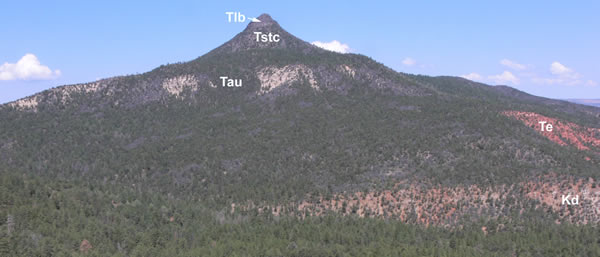
Figure 6. View from Mesa Escoba looking northwest toward Cerro Pedernal, showing the red synorogenic Eocene El Rito Formation (Te) resting on Dakota Sandstone (Kd). The Eocene rocks are overlain by Late Oligocene to Miocene basin fill sediments, including the Abiquiu Formation (Tau) and the Chama-El Rito Member of the Tesuque Formation of the Santa Fe Group (Tstc). Early Jemez volcanic field andesite and basalt (Tlb) top the peak.
The Eocene El Rito Formation is an orange-red to brick-red, hematitic, micaceous mudstone and siltstone with lenses of fine- to medium-grained arkosic sandstone (Figure 6). The El Rito Formation locally has a 2-to 10-m-thick basal conglomerate section made up of very well rounded hematitic Proterozoic Ortega Quartzite , as well as Proterozoic schist and gneiss cobbles and boulders (up to 1 m) derived from the Tusas Mountains (Figure 2) to the northeast. This unit overlies Cretaceous Mancos Shale, Dakota Sandstone, or Jurassic Morrison Formation with erosional unconformity and underlies the Abiquiu Formation.
The late Oligocene to early Miocene Abiquiu Formation is informally divided into three subunits (Smith, 1995). The oldest is the Lower Member, which is a pinkish tan to gray, generally coarse arkosic conglomerate and fine- to medium-grained sandstone derived from the Tusas Mountains to the northeast and the Sierra Nacimiento to the west (Figure 2). The lower conglomeratic member is poorly sorted, weakly to moderately indurated, calcareous, and characterized by well-rounded pebble to boulder-size (up to 50 cm) clasts composed of Proterozoic quartzite, granite, pegmatite, gneiss and schist, as well as fine-grained Pennsylvanian Madera limestone and mudstone. K-Ar ages on a basalt near the base of the unit northeast of this area and 40Ar/39Ar ages on Amalia Tuff in the Upper Member of the Abiquiu Formation bracket the age of the unit to be between 25.1 and 27 million years old (Smith et al., 2002, Moore 2000). The Pedernal Chert Member occurs at the top of the Lower Member, where it is locally interlayered with thin beds of arkosic sandstone and conglomerate. The varicolored, white, blue, gray, and black, cryptocrystalline, massive chert, limey chert, and limestone containing nodular chert is a conspicuous ledge former. Cerro Pedernal, which means "chert" or "flint mountain" derives its name from this unit. Pedernal Chert was mined and used by Native Americans to make arrowheads, spearheads, scrapers, and various other stone tools (Smith and Huckell, 2005). The upper sandstone member of the Abiquiu Formation is white, light gray, and buff-colored fine- to medium-grained, tuffaceous and volcaniclastic sandstone and mudstone derived from the Latir volcanic center to the north. A K-Ar age of 18.9 Ma from a basalt near the top of the unit and an Ar/Ar age of an Amalia Tuff clast of 25 Ma near the base bracket the age of the Upper Member (Smith and Huckell, 2005; Smith et al., 2002; Moore, 2000).
The Chama-El Rito Member of the Tesuque Formation of the Santa Fe Group is a poorly exposed, slope-forming unit comprised of moderately sorted, moderately indurated volcanic detritus with diverse lithologies, including pumice, basalt, intermediate volcanics and 25 Ma Amalia Tuff deposited by a southerly-flowing river system. A thin remnant of the Ojo Caliente Member of the Tesuque Formation (late Miocene) may be preserved under the 8 million year old andesite and basalt flows on Cerro Pedernal, but the exposures are so poor, its presence is uncertain. The Ojo Caliente Sandstone is an orangish-tan to tan-colored, well-sorted, fine-grained, cross-bedded, feldspathic and quartzo-feldspathic sandstone of eolian origin; this sandstone is well-cemented and forms cliffs in the vicinity of faults, but otherwise it is poorly cemented.
Structural History
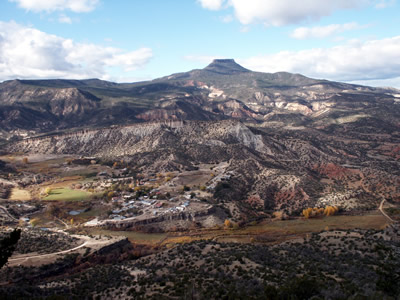
Starting about 75 million years ago, New Mexico, as well as most of the western United States, was affected by a compressive mountain building event known as the Laramide Orogeny (Cather, 2004). Some of fault zones in this area, such as the Cañones fault zone (Figure 7), were reverse faults during Laramide compression. These faults have since been re-activated as normal faults during Rio Grande rift extension (Gonzalez and Dethier, 1991; Gonzalez, 1993; Baldridge et al., 1994). Extensional faulting along the Cañones fault zone began with the deposition of the Upper Member of the Abiquiu Formation about 25 million years ago. Normal faults in this area were episodically active during the deposition of the Santa Fe Group prior to and after volcanism at 8 Ma. Some strands of the Cañones fault system do not offset 3 million year old flows in the Jemez volcanic field, suggesting that parts of the fault zone have been inactive since sometime between 8 and 3 million years ago. One strand of the fault system just southeast of Cerro Pedernal does offset the 1.2 million-year-old Tshirege Member of the Bandelier Tuff down to the east by approximately 2 m (Lawrence et al., 2004; Kelley et al., 2005a and b).
References
- Ahmed Benan, C.A. and Kocurek, G., 2000, Catastophic flooding of an aeolian dune field: Jurassic Entrada and Todilto formations, Ghost Ranch, New Mexico, USA: Sedimentology, v. 47, p. 1069-1080.
- Anderson, R.Y., and Kirkland, D.W., Origin, varves, and cycles of Jurassic Todilto Formation, New Mexico: Bulletin of the American Association of Petroleum Geologists, v. 44, p. 37-52.
- Baldridge, W.S., Ferguson, J.F., Braile, L.W., Wang, B., Eckhardt, K., Evans, D., Schultz, C., Gilpin,B., Jiracek, G.R., and Biehler, S., 1994, The western margin of the Rio Grande rift in northern New Mexico—An aborted boundary?: Geological Society of America Bulletin, v. 105, p. 1538-1551.
- Blakey, R.C., 1994, Paleogeographic and tectonic controls on some Lower and Middle Jurassic erg deposits, Colorado Plateau. In: Caputo, M.V, Peterson, J.A., Franczyk, K.J. (Eds.), Mesozoic Systems of the Rocky Mountain Region, USA. Rocky Mt. Sect., SEPM (Soc. Sediment. Geol.). Denver, pp. 273-298.
- Cather, S.M., 2004, The Laramide orogeny in central and northern New Mexico and southern Colorado, in Mack, G.H., and Giles, K.A., eds., The Geology of New Mexico, A Geologic History: New Mexico Geological Society Special Publication 11, p. 203-248.
- Gonzalez, M.A., 1993, Geomorphic and neotectonic analysis along a margin of the Colorado Plateau and Rio Grande rift in northern New Mexico: Albuquerque, University of New Mexico, unpublished Ph.D. dissertation, 302 p.
- Gonzalez, M.A., and Dethier, D.P., 1991, Geomorphic and neotectonic evolution along the margin of the Colorado Plateau and Rio Grande rift, northern New Mexico, in Julian, B., and Zidek, J., eds., Field guide to geologic excursions in New Mexico and adjacent areas of Texas and Colorado: New Mexico Bureau of Mines and Mineral Resources Bulletin 137, p. 29-45.
- Kelley, S.A., Lawrence, J.R., and Osburn, G.R., 2005a, Preliminary geologic map of the Youngsville 7.5-minute Quadrangle, Rio Arriba County, New Mexico, New Mexico Bureau of Geology and Mineral Resources, Open-file Geologic Map OF-GM 106, scale 1:24,000.
- Kelley, S.A., Osburn, G.R., Ferguson, C., Moore, J., Kempter, K. 2005b, Preliminary geologic map of the Cañones 7.5-minute quadrangle, Rio Arriba County, New Mexico, New Mexico Bureau of Geology and Mineral Resources, Open-file Geologic Map OF-GM 107, scale 1:24,000.
- Kocurek, G. and Dott Jr., R.H., 1983. Jurassic paleogeography and paleoclimate of the central and southern Rocky Mountains re gion. In: Reynolds, M.W., Dolly, E.D. (Eds.), Mesozoic Paleo geography of the West-Central United States. Rocky Mt. Paleo geogr. Symp., vol. 2. Rocky Mt. Sect. SEPM (Soc. Sediment. Geol.), pp. 101-1 16.
- Kowallis, B.J., Christiansen, E.H., Deino, A.L., Peterson, F., Turner, C.E., Kunk, M.J., and Obradovich, J.D., 1998, The age of the Morrison Formation: Modern Geology, v. 22, nos. 1-4, p. 235-260.
- Lawrence, J.R., Kelley, S., and Rampey, M., 2004, Preliminary geologic map of the Cerro del Grant7.5-minute quadrangle, Rio Arriba and Sandoval Counties, New Mexico, New Mexico Bureau of Geology and Mineral Resources, Open-file Geologic Map OF-GM 87, scale 1:24,000.
- Lucas, S.G., Kietzke, K.K., and Hunt, A.P., 1985, The Jurassic System in east-central New Mexico: New Mexico Geological Society Guidebook 36, p. 213-243.
- Lucas, S.G. and Anderson, O.J., 1998, Jurassic stratigraphy and correlation in New Mexico: New Mexico Geology, v. 20, p. 97-104.
- Lucas, S. G., Zeigler, K. E., Heckert, A. B., and Hunt, A. P., 2005, Review of Upper Triassic stratigraphy and biostratigraphy in the Chama basin, northern New Mexico: New Mexico Geological Society, Guidebook 56, p. 170-181.
- Manley, K., and Mehnert, H.H., 1981, New K-Ar ages for Miocene and Pliocene volcanic rocks in the northwestern Española Basin and their relationships to the history of the Rio Grande rift: Isochron/West, v. 30, p. 5-8.
- Moore, J.D., 2000, Tectonics and volcanism during deposition of the Oligocene-lower Miocene Abiquiu Formation in northern New Mexico, M.S. thesis, University of New Mexico, 144 pp.
- Owen, D.E., Forgas, A.M., Miller, S.A., Stelly, R.J., and, Owen, D.E., Jr., 2005, Surface and subsurface stratigraphy of the Burro Canyon formation, Dakota Sandstone, and intertongued Mancos Shale of the Chama Basin: New Mexico Geological Society Guidebook 56, p. 218-226.
- Peterson, F., 1994. Sand dunes, sabkhas, streams, and shallow seas: Jurassic paleogeography in the southern part of the western interior basin. In: Caputo, M.V, Peterson. J.A., Franczyk, K.J. (Eds.), Mesozoic Systems of the Rocky Mountain Region, USA. Rocky Mt. Sect., SEPM (Soc. Sediment. Geol.), Denver, pp. 233-271.
- Ridgley, J.L., 1977, Stratigraphy and depositional environments of Jurassic to Cretaceous sedimentary rocks in the southwestern part of the Chama Basin, New Mexico: New Mexico Geological Society Guidebook 28, p. 153-158.
- Ridgley, J.L., 1987, Surface to subsurface cross sections showing correlation of the Dakota Sandstone, Burro Canyon (?), Formation, and upper part of the Morrison Formation in the Chama-El Vado area, Chama Basin, Rio Arriba County, New Mexico: U.S. Geological Survey Map MF1496-D, 2 sheets.
- Smith, G.A., 1995, Paleogeographic, volcanologic, and tectonic significance of the upper Abiquiu Formation at Arroyo del Cobre, New Mexico: New Mexico Geological Society Guidebook 46, p. 261-270.
- Smith, G.A., and Huckell, B.B., 2005, The geological and geoarchaeological significance of Cerro Pedernal, Rio Arriba County, New Mexico: New Mexico Geological Society, 56th Field Conference Guidebook, Geology of the Chama Basin, p. 425-431.
- Smith, G.A., Moore, J.D., and McIntosh, W.C., 2002, Assessing roles of volcanism and basin subsidence in causing Oligocene-lower Miocene sedimentation in the northern Rio Grande rift, New Mexico, USA: Journal of Sedimentary Research, v. 72, p. 836-848.
- Tanner, W.F., 1965. Upper Jurassic paleogeography of the Four Corners Region. Jour. Sed. Petrology, v. 35, p. 564-574.
- Varney, P., 2005, Dakota outcrop geology and sequence stratigraphy, Chama Basin, New Mexico: New Mexico Geological Society Guidebook 56, p. 193-217.



